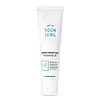What's inside
What's inside
 Key Ingredients
Key Ingredients

 Benefits
Benefits

 Concerns
Concerns

 Ingredients Side-by-side
Ingredients Side-by-side

Water
Skin ConditioningPropanediol
SolventPentaerythrityl Tetraethylhexanoate
EmollientCaprylic/Capric Triglyceride
MaskingGlycerin
HumectantHelianthus Annuus Seed Oil
EmollientPolyglyceryl-3 Methylglucose Distearate
EmulsifyingButyrospermum Parkii Butter
Skin ConditioningCetearyl Alcohol
EmollientPanthenol
Skin ConditioningMadecassoside
AntioxidantCamellia Sinensis Leaf Extract
AntimicrobialCeramide AP
Skin Conditioning1,2-Hexanediol
Skin ConditioningPotassium Carbomer
Emulsion StabilisingXanthan Gum
EmulsifyingButylene Glycol
HumectantDisodium EDTA
Water, Propanediol, Pentaerythrityl Tetraethylhexanoate, Caprylic/Capric Triglyceride, Glycerin, Helianthus Annuus Seed Oil, Polyglyceryl-3 Methylglucose Distearate, Butyrospermum Parkii Butter, Cetearyl Alcohol, Panthenol, Madecassoside, Camellia Sinensis Leaf Extract, Ceramide AP, 1,2-Hexanediol, Potassium Carbomer, Xanthan Gum, Butylene Glycol, Disodium EDTA
Water
Skin ConditioningGlycerin
HumectantIsostearyl Isostearate
EmollientIsopropyl Isostearate
EmollientIsosorbide Dicaprylate
Skin ConditioningBisabolol
MaskingGlyceryl Glucoside
HumectantCetearyl Olivate
Sorbitan Olivate
EmulsifyingCeramide NP
Skin ConditioningCeramide EOP
Skin ConditioningUrsolic Acid
MaskingPropanediol
SolventAdipic Acid
BufferingAdipic Acid/Neopentyl Glycol Crosspolymer
Phospholipids
Skin ConditioningCholesterol
EmollientLinolenic Acid
CleansingLinoleic Acid
CleansingStearic Acid
CleansingAmmonium Acryloyldimethyltaurate/Vp Copolymer
Tocopherol
AntioxidantDimethylmethoxy Chromanol
AntioxidantPolyacrylamide
C13-14 Isoparaffin
EmollientLaureth-7
EmulsifyingCitric Acid
BufferingDisodium EDTA
Phenoxyethanol
PreservativeEthylhexylglycerin
Skin ConditioningChlorphenesin
AntimicrobialWater, Glycerin, Isostearyl Isostearate, Isopropyl Isostearate, Isosorbide Dicaprylate, Bisabolol, Glyceryl Glucoside, Cetearyl Olivate, Sorbitan Olivate, Ceramide NP, Ceramide EOP, Ursolic Acid, Propanediol, Adipic Acid, Adipic Acid/Neopentyl Glycol Crosspolymer, Phospholipids, Cholesterol, Linolenic Acid, Linoleic Acid, Stearic Acid, Ammonium Acryloyldimethyltaurate/Vp Copolymer, Tocopherol, Dimethylmethoxy Chromanol, Polyacrylamide, C13-14 Isoparaffin, Laureth-7, Citric Acid, Disodium EDTA, Phenoxyethanol, Ethylhexylglycerin, Chlorphenesin
 Reviews
Reviews

Ingredients Explained
These ingredients are found in both products.
Ingredients higher up in an ingredient list are typically present in a larger amount.
Disodium EDTA plays a role in making products more stable by aiding other preservatives.
It is a chelating agent, meaning it neutralizes metal ions that may be found in a product.
Disodium EDTA is a salt of edetic acid and is found to be safe in cosmetic ingredients.
Learn more about Disodium EDTAGlycerin is already naturally found in your skin. It helps moisturize and protect your skin.
A study from 2016 found glycerin to be more effective as a humectant than AHAs and hyaluronic acid.
As a humectant, it helps the skin stay hydrated by pulling moisture to your skin. The low molecular weight of glycerin allows it to pull moisture into the deeper layers of your skin.
Hydrated skin improves your skin barrier; Your skin barrier helps protect against irritants and bacteria.
Glycerin has also been found to have antimicrobial and antiviral properties. Due to these properties, glycerin is often used in wound and burn treatments.
In cosmetics, glycerin is usually derived from plants such as soybean or palm. However, it can also be sourced from animals, such as tallow or animal fat.
This ingredient is organic, colorless, odorless, and non-toxic.
Glycerin is the name for this ingredient in American English. British English uses Glycerol/Glycerine.
Learn more about GlycerinPropanediol is an all-star ingredient. It softens, hydrates, and smooths the skin.
It’s often used to:
Propanediol is not likely to cause sensitivity and considered safe to use. It is derived from corn or petroleum with a clear color and no scent.
Learn more about PropanediolWater. It's the most common cosmetic ingredient of all. You'll usually see it at the top of ingredient lists, meaning that it makes up the largest part of the product.
So why is it so popular? Water most often acts as a solvent - this means that it helps dissolve other ingredients into the formulation.
You'll also recognize water as that liquid we all need to stay alive. If you see this, drink a glass of water. Stay hydrated!
Learn more about Water